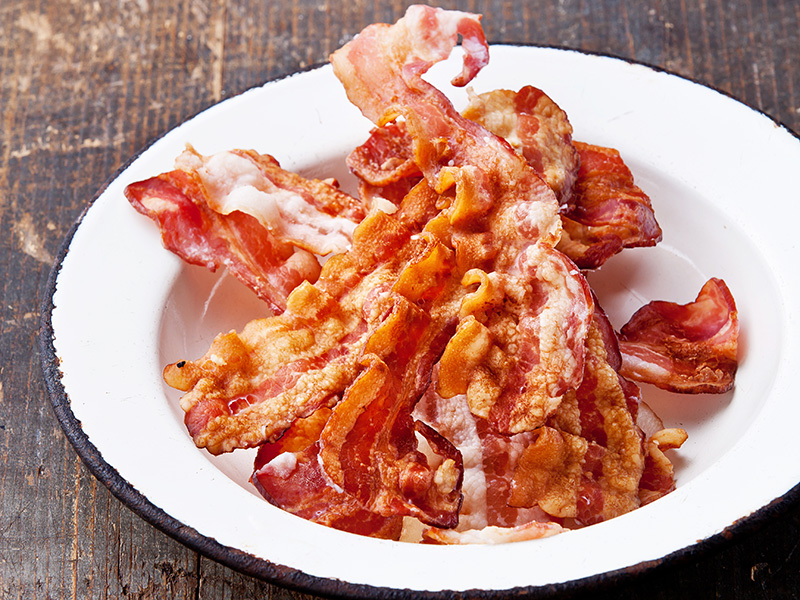Low Sodium Roasted Yam Soup with Bacon Bits
Servings
4Serving size
about 2 cups as an entree (or 1 cup as a starter)This recipe can be multiplied and makes good leftovers.
Serve with Caesar Salad or Cole Slaw or Grilled Caesar Salad or Warm Zucchini, Basil and Tomato Salad or Zucchini Salad

Ingredients
| 1 1/2 pound Sweet potato |
| 1 tsp. Olive oil |
| 1 medium White or yellow onions (diced) |
| 1 Tbsp. Dried or rubbed sage |
| 1/4 tsp. Dried mint |
| 1 cup No salt added vegetable stock |
| 1 cup Water |
| 1/4 tsp. Salt |
| 1 to taste Black pepper |
| 2 slice raw Bacon |
| 1 cup 2% milk |
Instructions
Preheat the oven to 325°F. Place the yams in the oven and bake for 40 minutes until slightly soft. Remove from the oven and let cool for about 10 minutes.
While the yams are cooking place the olive oil in a medium sauce pan over medium heat. Add the onion and cook for about 3 minutes.
Add the sage, peppermint, chicken stock, water, salt and pepper. Cover and cook for about 30 minutes and remove from the heat.
When the yams are cool, slice lengthwise and scoop out the flesh leaving the skins. Add the flesh to the pan with the soup. Cook for about 5 minutes and then puree until smooth. Add the milk and puree.
Reduce the heat to very low to keep the soup warm.
While the soup is keeping warm, place the bacon in a large skillet over medium-high heat. Cook on each side until brown but not crispy. Remove to a towel, pat dry and dice.
Slice the yam skins into a medium dice and add to the pan with the remaining bacon grease. Cook for about 5 minutes.
Add to the soup, stir and serve.
Serve this recipe with one of these vegetable side dishes.
Caesar Salad
Place the garlic, Worcestershire sauce, pepper, lemon juice, mustard, honey, parmesan cheese, and yogurt in a blender or mini-chopper and process until smooth. Chill for at least 2 hours. Rinse the lettuce, drain, and dry in a salad spinner or patting gently with paper towels. Slice the lettuce crosswise and…
Cole Slaw
Place celery seed, flour, dry mustard, granulated sugar, egg yolk, cayenne pepper, salt and milk in a blender. Blend on low while slowly adding the vinegar. Transfer contents of blender to a sauce pan and heat over high heat, whisking continuously. As the sauce heats, check the temperature with a…
Grilled Caesar Salad
Place the garlic, Worcestershire sauce, pepper, lemon juice, mustard, honey, parmesan cheese, and yogurt in a blender and process until smooth. Chill for at least 2 hours. Rinse the romaine lettuce well. Do not detach the leaves from the root. Cut the romaine lettuce lengthwise into two halves. Preheat a…
Warm Zucchini, Basil and Tomato Salad
Place the olive oil, vinegar, salt, pepper and maple syrup in a bowl, whisk and set aside. Slice the tomatoes in half and place in the bowl with the vinaigrette. Place the water in a medium stock pot over high heat. When the water comes to a boil, blanch the…
Zucchini Salad
Whisk together the olive oil, balsamic vinegar, maple syrup, salt, pepper and marjoram. Place in the refrigerator while cutting the zucchini. Cut the zucchini into medium dice. This should be about 1/4 inch cubes. Toss the zucchini, tomatoes and pine nuts together in the vinaigrette. Chill well before serving.

Would you like to print or download the document?
Special Diet Information
Click on the icon for information.










Lactose
Avoid this recipe if you are lactose intolerant.Recipe Notes
Yams make for the perfect base of a hearty soup. You’d never know that they’re good for you and the bacon and sage gives this a rich savory flavor. Serve with a side salad for a complete meal.



